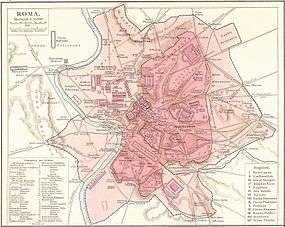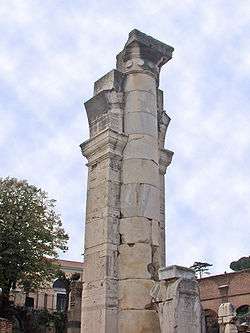Basilica Julia
| Basilica Julia | |
|---|---|
 Basilica Julia | |
| Location | Regione VIII Forum Romanum |
| Built in | 46 BC |
| Built by/for | Gaius Julius Caesar |
| Type of structure | Basilica |
| Related | Roman Forum |
 Basilica Julia | |
The Basilica Julia (Italian: Basilica Giulia) was a structure that once stood in the Roman Forum. It was a large, ornate, public building used for meetings and other official business during the early Roman Empire. Its ruins have been excavated. What is left from its classical period are mostly foundations, floors, a small back corner wall with a few arches that are part of both the original building and later Imperial reconstructions and a single column from its first building phase.
The Basilica Julia was built on the site of the earlier Basilica Sempronia (170 BC) along the south side of the Forum, opposite the Basilica Aemilia. It was initially dedicated in 46 BC by Julius Caesar, with building costs paid from the spoils of the Gallic War, and was completed by Augustus, who named the building after his adoptive father.
History and use

The building burned shortly after its completion, but was repaired and rededicated in 12 AD. The Basilica was again reconstructed by the Emperor Diocletian after the fire of 283 AD.
The Basilica housed the civil law courts and tabernae (shops), and provided space for government offices and banking. In the 1st century, it also was used for sessions of the Centumviri (Court of the Hundred), who presided over matters of inheritance. In his Epistles, Pliny the Younger describes the scene as he pleaded for a senatorial lady whose 80-year-old father had disinherited her ten days after taking a new wife.
It was the favorite meeting place of the Roman people. This basilica housed public meeting places and shops, but it was mainly used as a law court. On the pavement of the portico, there are diagrams of games scratched into the white marble. One stone, on the upper tier of the side facing the Curia, is marked with an eight by eight square grid on which games similar to chess or checkers could have been played.
The Basilica Julia was partially destroyed in 410 AD when the Visigoths sacked Rome[1] and the site slowly fell into ruin over the centuries. Part of the remains of the basilica was converted into a church in the 7th or 8th century. The building consists now only of a rectangular area, levelled off and raised about one metre above ground level, with jumbled blocks of stone lying within its area. A row of marble steps runs full length along the side of the basilica facing the Via Sacra, and there is also access from a taller flight of steps (the ground being lower here) at the end of the basilica facing the Temple of Castor and Pollux.
Archaeology and excavation
The site was excavated by Pietro Rosa in 1850 who reconstructed a single marble column and travertine supports. In 1852 segments of concrete vaulting with stuccowork coffering was unearthed but later destroyed in 1872.[2]
References
| Wikimedia Commons has media related to Basilica Julia (Rome). |
- ↑ http://sights.seindal.dk/sight/165_Basilica_Julia.html
- ↑ Claridge, Amanda; Toms, Judith; Cubberley, Tony (March 1998). Rome: an Oxford archaeological guide. Oxford University Press. pp. 89–90. ISBN 978-0-19-288003-1.
Coordinates: 41°53′31″N 12°29′06″E / 41.891979°N 12.484884°E